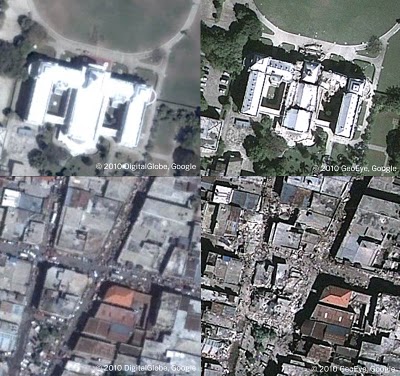
Image Credit: Google Lat Long Blog
If were you watching the news in mid-January, you likely saw
images like those above flashing repeatedly across your television or computer
screen. Unlike the
photojournalistic, street-level portraits that tend to document disasters,
these aerial shots, produced through a collaboration between Google Earth and GeoEye
(a satellite imaging company), have been prominent in the visual coverage of the
earthquake that hit Haiti on January 12, 2010. The above images show pre- and post-quake views of the Presidential Palace (top left; top right) and downtown Port au Prince (bottom left; bottom right), and were created using the timeline tool in Google Earth.
I’ve been interested in the prominent role that mapping and
satellite-produced imagery has played in the coverage and documentation of the
Haiti earthquake, partly for its own sake, and partly because I’m planning a Google
Earth-based collaborative writing activity for my Rhetoric and Writing class
this spring.
In the earthquake
coverage, the intimate, affect-laden portrait—framed by the human
eye, scaled to the human story—has remained prominent, of course, but has been augmented
by this second visual approach, which has, itself, received significant news
coverage. These visuals do not
function the same way photojournalistic visuals function; they do not focus on
the human situation; they do not construct an explicitly emotional appeal.
These sophisticated, accurate maps of damage have clearly
aided rescue and relief efforts.
Yet I’ve been wondering about the analytical impulses behind mapping and
its effects—especially given the debates during the past few weeks about
Haiti’s leadership, its autonomy, about who’s in control of relief
efforts.
The history of mapping is entangled with the history of
imperial expansion, shot through with impulses toward geographical
control. In what ways do these
contemporary mapping technologies address or confront the imperial history of
map-making? While much of the
mapping of Haiti has been accomplished through satellite imaging, Haiti has
also been mapped collaboratively, by countless individuals with diverse
motivations. (Google’s Haiti Map Maker project
encourages such collaborative, local mapping.) Similarly, Wikipedia’s “Haiti” page is currently ranked in
1885th place among the most-edited pages in the last 30 days, a number that,
while seemingly high, in fact indicates an extraordinarily high volume of recent edits. So, what effect does crowd-sourcing have on the implications
of mapping? Is crowd-sourced
mapping anti-imperialist mapping?
As I noted earlier, I’ve been considering all these
questions about mapping and its implications because I’m in the process of
planning a Google Earth-based collaborative writing activity with Geo-Everything’s
Caroline Wigginton. We’ll be using
Google Earth technologies to explore issues raised by Michael Pollan’s In
Defense of Food. The activity,
which will involve both of our RHE 306 classes, will take place in early
April. In preparation for this
collaboration, I’ll be using this blog throughout the spring semester to
discuss Google Earth, its applications for the literature, rhetoric, and
composition classroom, and, in particular, the potential it creates for
collaborative writing.
As I’ve begun to think through the possibilities, I’ve come
up with a few initial questions, which I’ll address (and likely add to) in the
coming weeks:
- For the purpose of the writing classroom, what
are differences between Google Earth and Google Maps?
- What are their different critical
capacities? How do they ask
students to conceptualize information differently?
- What are their different collaborative
capabilities? Is Google Earth
inherently more collaborative? How
can this capacity be used in the writing classroom?
- How might some of the conceptual and
technological features of Google Earth (the “fly to” function, the moveable timeline,
the placing of local sites in the context of a globe) enable writing and
thinking exercises that are different than those possible in Google Maps?
Recent comments
2 years 29 weeks ago
2 years 44 weeks ago
2 years 44 weeks ago
2 years 50 weeks ago
3 years 4 weeks ago
3 years 4 weeks ago
3 years 4 weeks ago
3 years 6 weeks ago
3 years 6 weeks ago
3 years 6 weeks ago